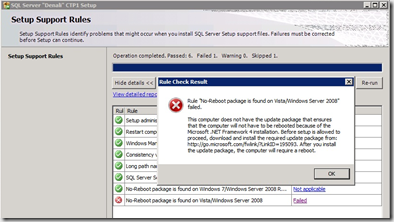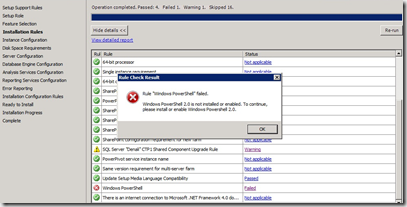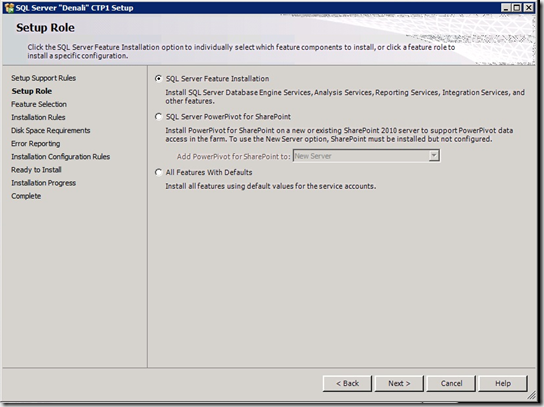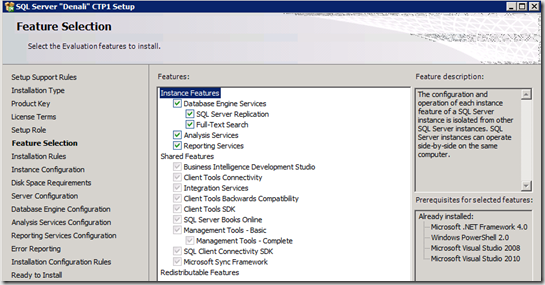SQL Denali CTP1 Installation
Just Installed the Denali CTP1. Some experience shared here. I used iso file and installed the Denali CTP in a Virtual Machine with Windows 2008 Standard, along with SQL Server 2008 Dev Edition with all components installed.
There are two requirements for the Denali CTP1 installation that you better pass before you got two separate stop errors on configuration and installation check steps
Microsoft .NET Framework 3.5 SP1 Update for Windows Vista and Windows Server 2008
Windows Management Framework Core package (Windows PowerShell 2.0 and WinRM 2.0)
If you miss the first requirement then you will get the following message in the beginning of your installation at the Setup Support Rule Check.
If you miss the second requirement you will get the error that Windows Power Shell 2.0 is not installed after you pass the feature selection at the Installation Rules Check.
Because my VM is a DC, I cant use the built-in Windows accounts for services, and I created a separate Domain user account for SQL Services. Your case may be different.
The are some strange rules listed in System Configuration and Installation Configuration Reports:
- BIDS2008InstalledCheck rule checks if any of SQL Server 2008 Business Intelligence Development Studio installation exists. It passed saying that SQL Server 2008 Business Intelligence Development Studio is not installed. Actually I have SQL Server 2008 with all the components Installed.
- Shared Components Upgrade Rule checks whether SQL Server "Denali" CTP1 shared components (such as IS, BIDS, Tools, SSMS, or BOL) are present on the machine, because installing SQL Server "Denali" CTP1 shared components will automatically upgrade the existing shared components. The rule generated a warning message showing that there are one or more shared components of SQL Server "Denali" CTP1 installed on the machine. It warns that installing SQL Server "Denali" CTP1 shared components will automatically upgrade the existing shared components. Actually It is the first time I am doing Denali Installation, so there is no way I am aware of to have its Shared components on the VM.
Changes in the Installation Process
Actually the installation is the same as SQL Server 2008 with very small changes.
There is a new Setup Role page in the installation allowing you to choose the General SQL Server Features that you want to install. If you want to install everything as SQL Services and Shared tools then you can simply choose All Features with defaults service accounts (puts system accounts for Services).
The All features doesn't save you the Features selection box, it just checks all features for you.
If you want just PowerPivot than you better prepare yourself for a lot of requirements and check for this installation, starting from 64-bit OS and ending with accounts for SQL server is SharePoint Farm requirement.
You can find all the Setup Rules requirements here, but the requirements for PowerPivot for SharePoint Installation are not listed in this link.
I found the following from my Boot strap Report:
| Rule Name | Description |
| ASSPI64bitsMachineCheck | Checks whether the computer processor meets the 64-bit requirement for installing SQL Server PowerPivot for SharePoint. |
| ASSPIExistingFarmRequiresMoss14FarmCheck | Checks for membership in a SharePoint Server 2010 farm. |
| ASSPIExistingFarmRequiresUpgradeCheck | Checks existing farm for SharePoint Server 2010. |
| ASSPIIISVersionCheck | Checks for Internet Information Services 7.0 or later. IIS 7.0 or later is required for installing SQL Server PowerPivot for SharePoint. |
| ASSPIInstanceNameNotInUseCheck | Checks for the required instance name. |
| ASSPINewFarmNeedsUpgradeToO14MossEnterpriseCheck | Checks for an un-configured SharePoint Server 2010. |
| ASSPINewFarmRequiresMoss14BitsCheck | Checks whether SharePoint Server 2010 is installed. |
| ASSPINewFarmRequiresMossBitsCheck | Checks whether the SharePoint server can be configured. |
| ASSPINewO14EnterpriseFarmUnconfiguredCheck | Checks whether Setup will be able to configure the local SharePoint server. |
| ASSPINo32BitsOrWowCheck | Checks whether Setup is running in a 64-bit process on a computer that is running a 64-bit operating system. This is required for installing SQL Server PowerPivot for SharePoint. |
| ASSPINoExistingIMBICheck | Checks for an existing instance of SQL Server PowerPivot for SharePoint. You can have only one instance of PowerPivot for SharePoint on a computer. |
| ASSPIOperationSystemCheck | Checks for the Windows Server 2008 or later operating system. This operating system is required for installing SQL Server PowerPivot for SharePoint. |
| ASSPIProvisionResultValidCheck | Checks whether all of the SQL Server PowerPivot for SharePoint instances in the farm are the same version. |
| ASSPISharePointPlatformSupportedCheck | Checks whether SharePoint supports current .Net Framework version. |
| ASSPIUserIsFarmAdminCheck | Checks whether the user running Setup is also a SharePoint farm administrator. |
I think I am not going to start the PowerPivto for SharePoint soon.
That is shortly the Denali Installation, pretty smart and easy. I am even thinking to repeat it on my laptop, seems that it is safe to play with (i remember those days when I had to prepare a separate and very isolated VM for installing first CTP of SQL 2005 :))
The most interesting and exciting part of playing with the product just begins. I found some new features in the SSMS already and I like them – the SSMS Add extended events that was a separate installation for 2008 is there, the SSMS itself looks very much like VS 2008. There are new Availability Groups and Integration Services folders that I am starting playing with. I know that there will be major changes to the SSIS, so i hope to find something in CTP1.
Will update you soon :)



